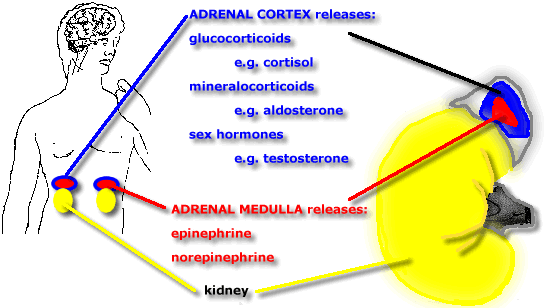Fitness Blog Covering Topics Of Interest
Thursday, November 26 2015
In his Autumn 2015 statement, the Chancellor pledges to spend £600m on mental health. Out comes the fan fare and heaps and loads of praise for him and his party on tackling the current unacceptable under funded mental health situation in England.
Let us, for a moment, step back and open the history books and look at mental health funding in England since 2010; the time when George Osborne, our Chancellor took office.
Funding for NHS trusts to provide mental health services has fallen by more than 8% in real terms since 2010, according to research by Community Care and BBC News. Figures obtained under the Freedom of Information Act from 43 mental health trusts in England show that total funding for the trusts’ mental health services dropped in real terms by 8.25 per cent, or almost £600m (once inflation has been accounted for). Now, after a reality check has been taken of the situation should we still be showering the Chancellor with praise for his generosity?.
In real terms, the Chancellor has been cutting funding to the most vulnerable persons in society, the mentally ill by £600m over the last 5 years and now we expect them to be thankful that he's giving it back. What sort of society do we live in where we make the most vulnerable suffer by not providing adequate services for them?. All that the Chancellor has done is to put mental health in England back to where it was in 2010 when he became chancellor and society should be grateful for this?.
Gym In Motion provides fitness programs to persons struggling with mental health illness. What we've seen over the past 5 years is the impact that the taking of £600m in cuts from the mental health services has had on the most vulnerable in society. Front line services being strained to their maximum, long waiting lines to access therapy while the majority of people with mental health issues just don't get any help at all. Society is denying these vulnerable people assistance in the name of saving money. Not only have I experienced this from a supplier's point of view, but from first hand experience as I have a number family members who suffer or have suffered with mental health illness over the years. No where, has any government minister, employee or consultant, looked behind the scenes and seen that by denying services to a person with a mental health illness, in most cases causes their mental state of mind to worsen and so they spiral into deteriation.
These are the consequences that are just brushed under the carpet, the consequences that aren't mentioned at dinner parties for they force society to take note of their actions which is not a pretty sight.
Somehow, I don't think that those with a mental health illness will be heralding our Chancellor for giving back to the mental health services, what was rightly there's in the first place. If I'm a cynical person, I'd say that this whole announcement was just for our Chancellor and government of the day to get brownie points and be seen to do something about a dire situation which they created in the first place. The uninformed will be thankful, the informed will not be amused.
References:
http://www.communitycare.co.uk/2015/03/20/mental-health-trust-funding-8-since-2010-despite-coalitions-drive-parity-esteem/
http://www.bbc.co.uk/news/health-31970871
https://www.mind.org.uk/news-campaigns/news/mental-health-services-cut-by-8-per-cent.aspx#.VlbJ5b-jKpA
http://www.cityam.com/229537/autumn-statement-2015-chancellor-george-osborne-promises-to-spend-an-extra-600m-on-mental-health
Wednesday, October 28 2015
Your bone strength and size peaks by age 30. After that, bones tend to become less dense, making them more fragile and subject to 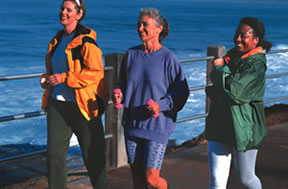 breaks. Bone strength in later life depends upon your peak bone mass in youth. An active lifestyle in youth can increase maximum bone density. breaks. Bone strength in later life depends upon your peak bone mass in youth. An active lifestyle in youth can increase maximum bone density.
Even if you’re older, exercise is still a great way to protect your bones. The physical stress placed on bones during exercise stimulates the growth of new bone tissue. The type of exercise you do matters. To bolster your bones, you need to get regular weight-bearing exercise. This includes weight lifting and resistance training, as well as any type of activity that forces you to work against gravity by standing or carrying your body’s weight, including running, walking, dancing, and stair climbing. Activities such as swimming or biking aren’t weight-bearing and thus don’t build bone. Generally, higher-impact activities (such as running) or resistance exercises (such as strength training) have a more pronounced effect on bone than lower-impact exercises, such as walking.
Only the bones that bear the load of the exercise will benefit. For example, running protects bones in the hips and legs, but not the arms. A well-rounded strength training plan can benefit practically all of your bones.
Because exercise improves your overall strength, coordination, and balance, it also makes you less likely to fall, which means less opportunity to break a bone.
To read more about the many benefits of exercise and learn how to start an exercise program that works for you, contact Ronald on 07929 256856.
Monday, October 05 2015
The next time you have a check-up, don’t be surprised if your doctor hands you a prescription to walk. Yes, this simple activity that you’ve been doing since you were about a year old is now being touted as “the closest thing we have to a wonder drug,” in the words of Dr. Thomas Frieden, director of the Centers for Disease Control and Prevention.
Of course, you probably know that any physical activity, including walking, is a boon to your overall health. But walking in particular comes with a host of benefits. Here’s a list of five that may surprise you.
1. It counteracts the effects of weight-promoting genes. Harvard researchers looked at 32 obesity-promoting genes in over 12,000 people to determine how much these genes actually contribute to body weight. They then discovered that, among the study participants who walked briskly for about an hour a day, the effects of those genes were cut in half.
2. It helps tame a sweet tooth. A pair of studies from the University of Exeter found that a 15-minute walk can curb cravings for chocolate and even reduce the amount of chocolate you eat in stressful situations. And the latest research confirms that walking can reduce cravings and intake of a variety of sugary snacks.
3. It reduces the risk of developing breast cancer. Researchers already know that any kind of physical activity blunts the risk of breast cancer. But an American Cancer Society study that zeroed in on walking found that women who walked seven or more hours a week had a 14% lower risk of breast cancer than those who walked three hours or fewer per week. And walking provided this protection even for the women with breast cancer risk factors, such as being overweight or using supplemental hormones.
4. It eases joint pain. Several studies have found that walking reduces arthritis-related pain, and that walking five to six miles a week can even prevent arthritis from forming in the first place. Walking protects the joints — especially the knees and hips, which are most susceptible to osteoarthritis — by lubricating them and strengthening the muscles that support them.
5. It boosts immune function. Walking can help protect you during cold and flu season. A study of over 1,000 men and women found that those who walked at least 20 minutes a day, at least 5 days a week, had 43% fewer sick days than those who exercised once a week or less. And if they did get sick, it was for a shorter duration, and their symptoms were milder.
Thursday, July 16 2015
Mobility — the ability to move purposefully around your environment — is vitally important to health and well-being.
Nearly one-third to one-half of adults ages 65 and older experience impaired mobility. At first, it may not seem like a big deal — many people with impaired mobility learn to just move a little more slowly and a little more deliberately. Some people work around the problem by relying on a cane or walker.
That’s why it’s important to intervene to either prevent future mobility impairments or reduce existing ones.But taking impaired mobility “lying down” can cause your health to spiral downward. As you move less, pounds may start to creep on. You might withdraw from social relationships and activities that challenge you mentally. Exercise may become difficult, and lack of activity can worsen many health problems. This cycle of physical, emotional, and mental decline further restricts mobility.
For most people, the ability to rely on their own bodies, skills, and mental agility is a crucial part of living a satisfying life. Having full mobility helps you fully engage with the world and fosters a sense of self-sufficiency that can help you live independently well into your later years.
Thursday, August 21 2014
If opening jars becomes more difficult because of painful hands, or if climbing stairs produces pain in your knees, “arthritis” is often the first thing that comes to mind. The two most common forms of arthritis—osteoarthritis and rheumatoid arthritis—can cause similar aches and pains, but there are a few key differences between them. For example:
Onset. Osteoarthritis occurs when cartilage (tissue in your joints that cushions your bones) wears away. Pain occurs when bone rubs against bone. This type of arthritis pain tends to develop gradually and intermittently over several months or years.
Osteoarthritis is the most common type of arthritis affecting 27 million Americans. Many people believe it’s a crippling and inevitable part of growing old. But things are changing. Treatments are better, and plenty of people age well without much arthritis. If you have osteoarthritis, you can take steps to protect your joints, reduce discomfort, and improve mobility — all of which are detailed in this report. If you don’t have osteoarthritis, the report offers strategies for preventing it.
Rheumatoid arthritis, on the other hand, is an inflammatory condition in which your immune system attacks the tissues in your joints. It causes pain and stiffness that worsen over several weeks or a few months. And joint pain isn’t always the first sign of rheumatoid arthritis—sometimes it begins with “flu-like” symptoms of fatigue, fever, weakness, and minor joint aches.
Location. Both osteoarthritis and rheumatoid arthritis can affect the hands. However, osteoarthritis often affects the joint closest to the tip of the finger, whereas rheumatoid arthritis usually spares this joint. And while rheumatoid arthritis can appear in any joint, its most common targets are the hands, wrists, and feet.
Type of stiffness. People often describe vague muscle aches as “stiffness,” but when doctors talk about “stiffness,” they mean that a joint doesn’t move as easily as it should. Stiffness may be prominent even when joint pain is not.
Mild morning stiffness is common in osteoarthritis and often goes away after just a few minutes of activity. Sometimes people with osteoarthritis also notice the same type of stiffness during the day after resting the joint for an hour or so. In rheumatoid arthritis, however, morning stiffness doesn’t begin to improve for an hour or longer. Occasionally, prolonged joint stiffness in the morning is the first symptom of rheumatoid arthritis.
Thursday, July 24 2014
Medications make a difference — generally a positive one — in the lives of many people. Insulin keeps blood sugar under control, cholesterol-lowering drugs can reduce the chances of having a heart attack, and thyroid medication can restore a normal hormone level. These are but a few examples.
At the same time, all drugs carry side effects, and can interact with other medications. For many medications, one or more side effects affect balance. And that can increase your chances of taking a fall. How? According to the Centers for Disease Control and Prevention, common problems include vision changes, dizziness or lightheadedness, drowsiness, and impaired alertness or judgment. Some medications may damage the inner ear, spurring temporary or permanent balance disorders.
How do I know if this is a problem for me?
Some of the commonly prescribed medications that can affect balance include:
- antidepressants
- anti-anxiety drugs
- antihistamines prescribed to relieve allergy symptoms
- blood pressure and other heart medications
- pain relievers, both prescription and nonprescription
- sleep aids (over-the-counter and prescription forms)
Sometimes the problem isn’t a single drug but the combination of medications being taken together. Older adults are especially vulnerable, because drugs are absorbed and broken down differently as people age.
If you are concerned about how your medications may be affecting your balance, call you doctor and ask to review the drugs you’re taking, the dose, and when you take them. It is never a good idea to just stop taking a medication without consulting your health care provider first. Doing so can create even more health risks.
Thursday, May 15 2014
The prostate is can be a troublesome little gland. It is prone to painful infections and inflammation (prostatitis), enlargement that interferes with urination (benign prostatic hyperplasia, or BPH), and cancer. Prevention is the best medicine, something exercise can help with. Exercise has also been shown to help treat various prostate-related conditions.
Although relatively few studies have looked at the impact of exercise specifically on prostate health, the ones that have suggest that regular physical activity can be good for this walnut-sized gland.
BPH prevention. In the ongoing Harvard-based Health Professionals Follow-up Study, men who were more physically active were less likely to suffer from BPH. Even low- to moderate-intensity physical activity, such as walking regularly at a moderate pace, yielded benefits.
Prostatitis treatment. Italian researchers conducted a randomized controlled trial (considered the gold standard of medical research) in men with chronic prostatitis. Those in the aerobic exercise group walked briskly three times a week. A comparison group did non-aerobic exercise (leg lifts, sit ups, and stretching) three times a week. At the end of 18 weeks, men in both groups felt better, but those doing aerobic exercises reported less prostatitis pain, less anxiety and depression, and better quality of life.
Prostate cancer progression. In a study of more than 1,400 men diagnosed with early-stage prostate cancer, men who walked briskly (not leisurely) for at least three hours a week were 57% less likely to have their cancer progress than those who walked less often and less vigorously. In an analysis from the Health Professionals Follow-up Study, men diagnosed with localized prostate cancer who engaged in vigorous activity at least three hours each week had a 61% lower chance of dying from the illness, compared to men who engaged in vigorous activity less than one hour a week.
How to get started
A well-rounded exercise program that includes a half-hour of physical activity on all or most days of the week delivers solid health benefits. And you needn’t perform this activity all at once; you can break it up into three 10-minute segments.
As always, talk to your doctor before beginning an exercise program. He or she can help you develop a routine based on your health and fitness level.
Saturday, February 15 2014
If you have diabetes — or for that matter, nearly any other chronic illness — exercise is one of the most powerful tools that can help you control your weight and blood sugar. And it can help you feel great, too.
The list of exercise benefits is long. Exercise helps control weight, lowers blood pressure, reduces harmful LDL cholesterol and triglycerides, raises healthy HDL cholesterol, strengthens muscles and bones, and reduces anxiety. Exercise can help regulate blood sugar and increase the body’s sensitivity to insulin. Both are important for people with diabetes.
Many studies have documented that exercise is a strong ally in treating diabetes. Here are a few examples:
- All forms of exercise — aerobic, resistance, and a combination of both — have been shown to be equally good at lowering HbA1c values.
- Resistance training and aerobic exercise both helped to lower insulin resistance in previously sedentary older adults at risk for diabetes. Combining the two was better than either one alone.
- People with diabetes who walked at least two hours a week were less likely to die of heart disease than their sedentary counterparts, and those who exercised three to four hours a week cut their risk even more.
- Women with diabetes who spent at least four hours a week doing moderate or vigorous exercise had a 40% lower risk of developing heart disease than those who didn’t exercise.
If you have diabetes, generally it is best to exercise one to three hours after eating, when your blood sugar level is likely to be higher. If you use insulin, be sure to test your blood sugar before exercising. If it is below 100 mg/dL, eat a piece of fruit or have a small snack. This will bump your blood sugar up and help you avoid hypoglycemia. Test again 30 minutes after your snack to be sure your blood sugar level is stable. It’s also a good idea to check your blood sugar after any particularly grueling workout or activity. If you’re taking insulin, your risk of developing hypoglycemia may be highest six to 12 hours after exercising. Experts also caution against exercising if your blood sugar is too high (over 250).
A medical alert bracelet should be part of your workout wardrobe. It should indicate that you have diabetes and whether you take insulin. Also, keep hard candy or glucose tablets with you while exercising in case your blood sugar takes a nosedive.
To learn more about how to live a healthy life with diabetes and ways to keep your blood sugar in check and avoid complications, contact Ronald @gyminmotion 07929 256856.
Thursday, January 23 2014
Even the healthiest people can find it hard to stick with an exercise regimen — and if you suffer from the joint pain of arthritis, moving your body may be the last thing you want to think about. But regular exercise not only helps maintain joint function, but also relieves stiffness and reduces pain and fatigue.
If you have arthritis, you want to be sure your exercise routine has these goals in mind:
- A better range of motion (improved joint mobility and flexibility). To increase your range of motion, move a joint as far as it can go and then try to push a little farther. These exercises can be done any time, even when your joints are painful or swollen, as long as you do them gently.
- Stronger muscles (through resistance training). Fancy equipment isn’t needed. You can use your own body weight as resistance to build muscles. For example, the simple exercise described below can help ease the strain on your knees by strengthening your thigh muscles. Sit in a chair. Now lean forward and stand by pushing up with your thigh muscles (use your arms for balance only). Stand a moment, then sit back down, using your thigh muscles.
- Better endurance. Aerobic exercise — such as walking, swimming, and bicycling — strengthens your heart and lungs and thereby increases endurance and overall health. Stick to activities that don’t jar your joints, and avoid high impact activities such as jogging. If you’re having a flare-up of symptoms, wait until it subsides before doing endurance exercise.
- Better balance. There are simple ways to work on balance. For example, stand with your weight on both feet. Then try lifting one foot while you balance on the other foot for 5 seconds. Repeat on the other side. Over time, work your way up to 30 seconds. Yoga and tai chi are also good for balance.
Arthritis doesn’t have to keep you from enjoying life.
Tuesday, December 31 2013
One night, you're in a bad neighborhood. A grungy thug comes out of nowhere and starts chasing you down the block. Suddenly, you are able to run faster and longer than you thought you ever could. And this is because your sympathetic nervous system has taken charge, which stimulates your adrenal glands to work harder.
But say you have a work assignment that is due the next day, the baby is crying even though you need to get dinner ready for your guests, your other child is screaming at you, and the TV is on full blast in the other room. Your body still interprets this as being under severe stress. The sympathetic nervous system has a hard time shutting off, the adrenal glands are overworking, and problems occur. Unfortunately, modern life often has overstimulation and a lot of pressures and difficulties that keep the sympathetic nervous system in fight-or-flight mode continually.
So where exactly are the adrenal glands? The kidneys are located in the lower back region, right around the second lumbar section of the spine just under your waistline, depending on the person. The adrenal glands are situated right above the kidneys.
The body is a whole universe with an extensive communication network. The body's nervous system breaks down into two parts: the central nervous system and the peripheral nervous system. The autonomic nervous system is part of the peripheral nervous system. The autonomic nervous system is responsible for involuntary movements and actions. It controls heartbeats, breathing, digesting, sweating, crying, etc. It is divided into the sympathetic and the parasympathetic nervous systems.
The sympathetic nervous system controls the fight-or-flight response. This means how your body responds to emergency and stressful situations. When the sympathetic nervous system is switched on your parasympathetic nervous system is switched off so that your body can cope with the emergencies more efficiently. When the sympathetic nervous system is on your heart rate increases, you sweat, your pupils dilate, and your body shuts down your digestion system so that it can focus on dealing with the emergency.
The parasympathetic nervous system kicks in when the sympathetic nervous system switches off. Your heart rate returns to normal, your digestion system starts back up, and body functions return to normal.
Although the nervous system's main communicators as neurons, the endocrine system's main communicators are chemical messengers known as hormones. Hormones are carried in the bloodstream to specific areas of the body, including organs and body tissues. Some of the most important endocrine glands include the pineal gland, the hypothalamus, the pituitary gland, the thyroid, the ovaries, and the testes.
When the sympathetic nervous system has been in flight-or-fight too long, it affects the hormones of the adrenal system. Too little or too much of the hormones can lead to adrenal fatigue and because of the way this fatigue impacts the body, it can lead to illness. This process of adrenal fatigue does not happen all at once. Instead, it is a gradual breakdown in the body.
The Three Phases of Stress
In 1956, endocrinologist Dr. Hans Selye developed a key concept in the study of stress and its effects on the body, which he termed, the general adaptation syndrome. In the general adaptation syndrome, the body passes through three phases in the way it copes with stress:
- Alarm Phase
- Resistance Phase
- Exhaustion Phase
1. Alarm Phase
In the alarm phase, the adrenal glands increase the amount of hormonal secretions in an attempt to maintain homeostasis (normal functioning of the body). The sympathetic nervous system is in excess. When the sympathetic nervous system is on and the parasympathetic nervous system is off, there will be a deficiency with digestion, the sex organs, the urinary tract, and less energy is being sent to these systems in order to deal with the more immediate crisis. That means blood is shunted away from hands, skin, feet, and the digestive tract (stomach and intestines) to the brain and the immediately important organs in the torso like the heart.
This can cause those raised knotted shoulders, tight upper back and neck, chills along the spine, clammy hands, cold feet, increased heart rate, a tight locked pelvis, and tight leg muscles. A good example of this is in someone who has just had a car accident - a hugely stressful event. Just as their body responds to stress by causing the upper back and legs to tighten, the muscles are jerked quickly, causing injury that can take time to heal. On the other hand, the body does this to stay alive, so that the heart can keep pumping blood even under poor circumstances, and so the person won't feel pain as quickly - that's the beauty of the sympathetic nervous system's response. In the alarm phase, stress is relatively short lived and the return back to homeostasis is with ease.
A list of what happens during a fight-or-flight response:
- The sympathetic nervous system response goes into excess as the body mobilizes by bringing large amounts of glucose and oxygen to the organs to ward off danger.
- Non-essential parasympathetic functions like digestive, urinary, and reproductive systems are inhibited.
- Adrenocorticol secretion rises sharply, raising the blood pressure and producing symptoms of sympathetic system hyperactivity.
Symptoms: Shortness of breath, palpitations, emotional instability, headache, back pain, decrease in frequency and quantity of urination, insomnia, lack of appetite, dizziness, nausea, eye pain, cold hands and feet, tight neck and upper back muscles.
Options on how to treat this stage:
- B-Vitamins: B-Vitamins help the body deal with stress better. Deficiencies in B Vitamins can cause muscle cramping and depression, but certain B Vitamins (for example, B-5) are also necessary for adrenal gland function.
- Magnesium: Magnesium can help both the skeletal and smooth muscle cramping that can be experienced as a result of stress. Because magnesium relaxes muscle, it can be helpful for stress-induced Anxiety or asthma attacks, and for lowering blood pressure.
- Electrolytes: After a stressful event or exercise, electrolytes like sodium and potassium can be lowered as well and these electrolytes are necessary for fluid balance in the tissues and regulating transport along cell walls. Also, sodium is closely involved in the regulation of the adrenals. Lack of sodium and potassium can cause swelling, as well as muscle weakness, fatigue, muscle cramps, fatigue, and mental confusion. If you have hypertension, you should check with your doctor about this because there may be a correlation between potassium deficiency and high sodium consumption in the diet of hypertensive patients.
- Vitamin C: Among other reasons to take Vitamin C (there's a list!) ACTH stimulation causes marked loss of ascorbic acid from the adrenal cortex. ACTH is what stimulates cortisol production when there is stress.
- Cutting down on coffee consumption: Coffee stimulates the adrenal glands, so if you are having problems with stress, this would be an important thing to cut down on. Try going without the afternoon cup and just having one cup in the morning.
- Drinking Water: Drinking water is important for treating stress as your body needs it for virtually every function so it's easier for your body to bounce back if it's hydrated. If you haven't been drinking water, you can begin drinking more along with taking in essential fatty acids and lecithin.
- Lecithin: Lecithin helps cell walls repair tissue and helps organ hydration and function.
- Essential fatty acid (EFA): EFAs attract water to dehydrated cells and connective tissue and maintain cell hydration.
- Meditation: Meditating for at least 5 minutes a day will help the body to relax, mitigating the effects of stress and keeping you from moving to stage 2.
- L-Theanine: If you have sudden high spikes of stress leading to extreme stress symptoms this is a great supplement. A good example is if you have test Anxiety, panic attacks, extreme sweating, and blanking out in stressful situations. L-Theanine is an amino acid taken from tea leaves, such as green tea, that creates a sense of relaxation 40 minutes after ingestion. This works in two different ways. It stimulates the production of alpha brain waves, creating a state of deep relaxation and mental alertness similar to what is achieved through meditation. It is also involved in the formation of gamma amino butyric acid (GABA), which influences two other neurotransmitters, dopamine and serotonin, producing the key relaxation effect.
- Rhodiola Rosea root: Rhodiola rosea root supports the functioning of the adrenal glands and encourages a healthy response to physical, emotional, and mental stress by normalizing cortisol levels and other stress-related hormones. If used regularly, it enhances the body's natural resistance and adaptation to stressful influences. In some people it can make you hyper, so take with caution.
2. Resistance Phase
According to Hans Selye, M.D., traumatic situations cause an elevated function of the adrenal glands. If this elevated activity is prolonged, the adrenal gland will be overworked and become exhausted, and thus be unable to release adequate amounts of adrenal hormones, such as cortisol and epinephrine.
In the resistance phase, constantly reacting to stress leaves the body depleted, leading to a general decrease in overall resistance to illness, inflammation, and pain. Stress is wearing the body out even though the body is still resisting it. There is constant energy being sent by the adrenals and sympathetic nervous system to only the most important organs for a flight-or-fight circumstance. For example, since digestion is a parasympathetic function, undigested food begins to enter the colon, causing gas and bloating, and as the body can't pull the nutrients out of food as efficiently, there are less number of important nutrients to keep the body healthy and pain free. Secretion of the adrenal hormones is initially still high, but slows down as they begin to wear out. The sympathetic nervous system weakness leads to sympathetic deficiency. The parasympathetic nervous system begins to become more dominant as it attempts to compensate.
The parasympathetic nervous system will switch on and take over, but not because the sympathetic nervous system has switched off, but because it's so exhausted that the parasympathetic nervous system has to pick up the slack so the body can function. What occurs is a constriction of blood vessels such as capillaries and arteries in the brain, excitement of the digestive system, and adrenal gland deficiency along with a whole host of problems listed below.
What happens during the Resistance Phase?
-Parasympathetic dominance
-Sympathetic exhaustion
-Adrenal gland exhaustion
What kind of patient has moved from the Alarm Phase to the Resistance Phase?
- The adrenal gland exhaustion sign is most active on those who have suffered or are suffering from shock, trauma, or extreme stress.
- This could be a person under chronic stress, who has a sudden trauma or a big life change.
- This could be a person under chronic stress who has had past trauma that still challenges them in some way (car accidents, sexual abuse, child abuse, psychological abuse, fear of death).
- People may have also had many children or many abortions, have had surgery(s), a history of chronic disease and pain. Also, drug abuse or a history of strong medication can lead to this stage.
Symptoms:
- Feeling tired, low back pain, shoulder pain and muscular tightness in whole body. Other symptoms include lack of sweat (except on palms of hands), cold lower back, cold abdomen, cold extremities.
- Upper respiratory tract symptoms: Constriction of airways and wheezing, shortness of breath and coughing. Allergic asthma may have presented itself in the alarm phase but is more typical in the resistance phase.
- Urinary Tract symptoms: Parasympathetic system dominance can stimulate contraction of the bladder, causing frequent urination.
- Gastrointestinal symptoms: abdominal pain, cramps, diarrhea, excessive salivation and gas.
Options on how to treat this stage:
All the recommendations from Stage 1 will help, but here are a few more for the more severe stage 2. All of these should be checked out with a doctor first as you may be having more severe symptoms stemming from stress (for example, high blood pressure):
- Holy Basil: Holy Basil is an Ayurvedic herb that supports a healthy response to stress, nourish the mind, and elevate the spirit. It contains a variety of constituents, including eugenol, camphor, caryophyllene, ursolic acid, luteolin and apigenin that function collectively to normalize stress hormones and enhance adrenal function.
- Ashwaganda: Ashwaganda is an Ayurvedic herb and an adaptogen that supports mental and physical Vitality and stamina. It contains steroidal compounds and additional chemical constituents that advance the body's natural resistance and adaptation to stressful influences. It supports mental endurance, promotes total metabolic efficiency and encourages an overall sense of well-being.
- Schizandra berries: Schizandra (Wu Wei Zi in Chinese medicine) is an adaptogen that promote overall health and Vitality, enhances the body's natural resistance to stressful influences, supports mental endurance and promote overall metabolic efficiency. This is also an astringent herb, so it may help if diarrhea and having to urinate too often are symptoms.
- Try different relaxation techniques: Meditation, deep breathing, long hot baths, relaxing yoga classes, journaling. You need to find something that relaxes you that you can do every day. This seems simple but is a great help for your body.
- Avoid sodium: Avoid sodium if high blood pressure is a symptom. In restoration of the adrenal gland function, typically one should include potassium rich foods and avoid foods that are too high in sodium.
- Cut out coffee completely: Coffee stimulates the adrenal glands and in this phase, they are over-stimulated. At this point, you need to do everything you can to calm them, so this is the time where you actually should consider not just cutting down on coffee, but quitting entirely.
- Cut out smoking: Smoking inhibits the ability of your lungs to breathe so it can be really important to quit at this phase.
- Cut out or significantly lower sugar: The injury to the sympathetic nervous system and adrenal gland weakness can affect the way your body metabolizes glucose. This may be especially important if you are diabetic (chromium increases the ability of your body to metabolize glucose, so this may be something to look into if that's a problem). Sugar will also increase inflammation.
- Watch out for inflammation symptoms: Increases in body pain, sudden muscular tension, allergy attacks, and new food allergies - all of these are signs of inflammation which are common in this stage. Turmeric /curcumin can help with this, as can essential fatty acids, but the inflammation may be happening because stress is affecting the body.
- Ginger: Ginger is very warming, and if you are constantly feeling cold due to stress, this would be a great tea to make you can buy ginger at any grocery store and slice a few pieces to make tea out of. It works in soups too.
- Bitters: Bitters might be good to take at this time if digestion and elimination is a large problem.
- Overstimulation: If you are experiencing an inability to relax even when exhausted, you might try making a tea out of linden flowers, skullcap, passionflower, and chamomile, but make sure you aren't driving and have a night of relaxation and sleep ahead of you.
Stage 3: Exhaustion Stage
- This stage occurs only when stress is extremely severe or when it continues over a long period of time.
- If stress continues to this level, cortisol secretion increases above normal rate and may even surpass levels produced by alarm reaction. However, the body's adaptive mechanisms are not adapting, they are decreasing.
- The body is not able to successfully cope with the stressor.
Possible Consequences of Exhaustion Phase:
- Arthritis, arteriosclerosis, nephrosclerosis, gastrointestinal ulcers, hypertension, etc.
- Prolonged exposure to high levels of cortisol and other hormones involved in the resistance reaction causes wasting muscle, suppression of immune system, and pancreatic beta cells.
- Even if changes are made in lifestyle now, resistance reactions persist even after stressor is gone.
- Serious diseases like Cushing's syndrome and adrenal diabetes may occur.
- Due to the fact that the body's systems are very much out of homeostasis, a multitude of problems may now occur and so we won't discuss natural remedies and supplements as this is the more emergency stage where you must work with a doctor.
Sources
- Bodymind Energetics Towards a Dynamic Model of Health. By Mark Seem, Ph.D.
- Kiiko Matsumoto's Clinical Strategies Volume 1. By Kiiko Matsumoto and David Euler
- Principles of Anatomy and Physiology. By Tortora and Derrikson
- The Ciba Collection of Medical Illustrations, Volume 4, Endocrine System and Selected Metabolic Diseases. By Frank H. Netter, M.D.
- Color Atlas of Human Anatomy. By R.M.H. McMinn and R.T. Hutchings
- The Stress of Life. By Hans Selye, M.D.
- Natural Health Complete Guide to Medicinal Herbs. By Penelope Ody, MNIMH
- Medical Nutrition From Marz, 2nd Edition. By Russell B. Marz, N.D., M.Ac.O.M
Wednesday, March 13 2013
The prostate gland depends on testosterone for growth and development. Prostate cells, both noncancer and cancer, do too. This is why prostate cancer is sometimes referred to as a hormone-dependent cancer. Higher levels of circulating testosterone lead to higher concentrations in the prostate, and this appears to increase the risk of clinically significant prostate cancer. However, higher testosterone levels are not consistently found in prostate cancer patients, so there is more to the relationship.
A possible protective role of exercise has been proposed based on its ability to lower testosterone levels and to boost the immune system. Exercise causes a temporary reduction in testosterone, so regular exercise can reduce long-term exposure to testosterone. And chronic exercise has been shown to increase the number and activity of natural killer cells, which are part of the immune system that attack cancer cells.
Based on these effects, it seems that exercise should be beneficial, but the evidence concerning the impact of exercise on prostate cancer risk is inconclusive. In a review of 17 epidemiological studies of varying quality, 9 showed a beneficial effect, 5 no effect, and the other 3 actually showed an increased risk related to exercise or physical activity. None of the studies, however, provided conclusive proof, but taken together, they seem to support a weak beneficial effect of regular exercise on prostate cancer risk.
The challenge is proving that men who exercise regularly develop less prostate cancer when all other factors are the same. This requires a prospective long-term randomized study, and this probably will never be done. The best long-term prospective studies that looked at habitual physical activity in adulthood are encouraging, however.
A study of nearly 18,000 alumni of Harvard University showed that those who maintained a high level of physical activity were about half as likely to develop prostate cancer after the age of 70 as those who were least active. Another prospective study evaluated the level of physical fitness, as well as physical activity, on the risk of prostate cancer. Higher fitness levels were associated with lower risk in men under 60, but not in older men. And men who expended more than 1,000 kcal per week in exercise had lower risk than those who did not get this much exercise. The best long-term study of men's health is the Health Professionals Follow-up Study. It began in 1986 and has followed over 47,000 men in various health occupations since then. Data was collected in the beginning, and periodically through the study, on many factors including physical activity. The only positive result through 1994 was that at least 3 hours per week of vigorous physical activity was associated with a reduced risk of metastatic prostate cancer. But no relationship was observed between physical activity and the incidence of total or advanced prostate cancer. The same study, however, found an inverse relation between physical activity and BPH, more activity meant a lower likelihood of urinary symptoms or surgery for BPH. Walking 2–3 hours per week was enough to lower the risk of BPH.
The bottom line is that questions remain about the relation between exercise and prostate cancer, but there is no question that regular exercise is good for general health. So, it is wise to get some moderate exercise on most days of the week, and you may be protecting yourself from prostate problems, too.
Monday, November 12 2012
The story of a four-year-old boy in India who has been running distances of up to 60 kilometers has led to a lot of discussions, including among the Take The Magic Step® team. We spoke to Dr. Henning Ohlert about appropriate exercise for young children, as well as about some strategies for parents to deal with this issue.
Dr. Ohlert, 46, is a lecturer of training science at the University of Potsdam. He was a professional athlete for ten years, and as a 23-year-old ran the 800 meters in 1:45.9. He is working on a long-term study of motor skills and development of ten-year-old children.
 © Betty Shepherd
© Betty Shepherd
How much exercise can a child cope with?
Over the years, our attitude towards children’s capabilities has changed tremendously. Basically, you could say that children are “little champions of endurance.” The big advantage of children is that they stop what they are doing automatically when they feel that they are getting tired and reach their physical limits. If children are tired out during playing, they simply take a break, and once they have recovered, they get active again. I think that you cannot do anything wrong with children-you just cannot challenge them physically in the wrong way. They know how to adjust themselves, and will utter their disapproval when it gets too much for them. And this disapproval should be respected.
What you have to watch out for with children, however, is problems with their thermoregulation; that is, the loss of body warmth during physical activity. Children get red faces when they are playing, bouncing around or playing sports. The body warmth which develops causes fast panting while breathing. The reason for this is that their perspiration system with does not function as that of an adult yet. That’s why you have to be careful to prevent children from overheating. In general, however, children have quite a sensitive feeling for the right proportion of activity and rest. It is highly dangerous, though, what is demanded of the little boy in India.
How can parents tell what and how much they can expect and ask from their children?
I believe you can ask more from children than most parents would think. You can judge by certain subjective criteria if a physical activity is enough: the color of the skin (for example, if the paleness of the skin is extreme), the frequency of the breath, the heart rate as well as the quality of movements. You will realize pretty quickly that movements seem to become uncontrolled and the way children fall changes. These are clear indications for the necessity of a break.
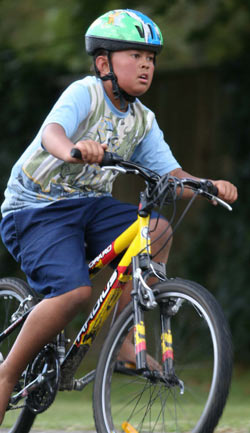 © Betty Shepherd
© Betty ShepherdAt what age should children start to train on a regular basis?
In order to answer this question, you would have to define the term “systemically organized training” first. I think that until a child has reached the age of eight, we shouldn’t call it training. There is nothing wrong with daily exercise or physical activities. Children should be active in various non-specific ways and thereby gain a broad range of experiences. This is the best prerequisite for successful involvement in sports later on.
Is there such a thing as unathletic children?
In my opinion, there is no such thing as unsporty kids. At times someone gets called “unathletic” just because he is judged by certain skills and abilities. It is just normal, however, that you are not able to do things which you have never done or practiced before. Often you get also judged by your family background. But just because your parents consider themselves unathletic, it does not necessarily have to mean that the son or daughter is as well. Every child is athletic. The question is only if she is athletic enough to become a champion.
Don’t children have a natural urge to move?
Absolutely. Unfortunately, this urge is lost throughout the ontogenetic development. At puberty, this urge to move decreases. This is when young athletes often lose interest in their sport and don’t show up for training anymore.
Should parents try to intervene?
It would not be good if the enthusiasm for the sport got completely lost. It is normal and should be tolerated that there are phases of less motivation. You should still try to talk to your child, his or her coach and friends about the situation, options and possible wasted opportunities.
Children tend to change their enthusiasm for different things quite quickly. Today they are playing tennis, tomorrow they want to become a professional swimmer, the day after tomorrow a famous basketball player. Sometimes they are not sure at all. Should children do several kinds of sport or should they better concentrate on one?
I strongly recommend that children experience a rather broad range of physical activities. I assume that not every child should be trained to become a Davis Cup player. Instead, most children will just want to play tennis for fun, or they just want to go inline skating, running or play soccer. I am a great supporter of children practicing a variety of sports.
Is it naive to believe that children will be grateful one day if parents put some pressure on them and force them to keep up a certain sport, hoping that they will be successful and the sport turns out to be the right one for the child?
This wish or hope might be honorable, but children think differently. Children think very emotionally, and are not as rational as adults are. The reasons why children give up on something are not easily understood. A little bit of pressure might not be wrong. It is a great achievement, however, if children discover themselves what they like.
Should parents tell their children which expectations they have regarding their sporting performance?
Parents’ expectations should not put too much negative pressure on the children. There is a lot of evidence in pedagogy that children fail just because their parents were asking too much of them. Children often act paralyzed if they are put under too much pressure. Then they are often criticized for failing mentally, but no one realizes how much pressure has been put on them: “You have to do this, you have to do that!”
Parents have to learn to judge their children’s mental condition and figure out how they can teach them ambition and determination. As a matter of fact, a runner participates in a race to get to the finish line among the best and not far behind the first ones. Consequently, you can, of course, tell your children that sport is often about being better and faster than others. This should be done sensibly, however, and without any pressure. It is nearly impossible to get children’s enthusiasm back if you have put them off doing sports once and if sports have become a trauma for them. This is proven by scientific research. The next chance you get to convince them of doing sports again is when they have grown up and when stress at work and an unhealthy diet have caused health problems and the cardiologist tells them, “You have to get moving, you have to exercise!”
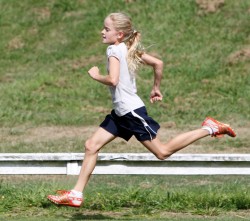 © Betty Shepherd
© Betty Shepherd
On the other hand, children are often highly motivated when their parents watch them at training or competitions.
It is obvious that children are extremely motivated when they realize that their parents fully support what they are doing. At some stage, however, their own motivation will become so high that they don’t need their mother’s or father’s support anymore. But even professional athletes are more motivated when their parents are in the stadium or along the race course, no matter if in tennis, soccer or running. The question is just how parents react to their children’s failure. It is important that you find out together-maybe even with the coach-where mistakes might have been made and how you could adapt the training. Children have to feel that you support them and don’t give up on them.
What should parents do if their child suddenly, after two years, does not like judo anymore and would rather want to do athletics or tennis? Should parents demand that their children continue doing what they have started to do and not to give up on something just because it is no fun at the time?
I don’t find it too bad to change from one kind of sport to the other. You should have a conversation and clarify why they don’t like the sport they used to do anymore. There are certainly understandable reasons for it. And if they are not understandable, you still should not act against your child’s wish.
What should parents do if they recognize sporting talent in their child, but are not sure if they want to support it?
If someone thinks his child has got talent in some area which is illustrated by being better at something than other children of the same age, I would recommend approaching a sporting club close by and asking if there are facilities to support this talent specifically. I don’t find it very good to place children in “talent factories” far away from home where they waste a lot of time traveling to and from the place. Children should be able to pursue their training without many hassles. If they further develop and prove their talent, there are more opportunities of support in young adulthood, such as elite sporting schools or scholarships.
And vice versa: How are mothers and fathers to act if children desperately want to become professional athletes, but just seem to lack the talent?
I would still give the child the same chances, as eventually the “moment of truth” will show if the child is as good as she thinks she is. In cases of constant failure, however, you should be honest with your child, and tell him that another kind of sport might be more suitable for him. There are a lot of children who change to another kind of sport after the advice of a friend or parents and who have become really successful at it. Children who are motivated and ambitious should initially do what they prefer and should try things out.
If parents for some reason think that they should apply sanctions against their child-maybe because of bad marks at school-are prohibiting going to training and doing sports reasonable disciplinary measures?
I find prohibiting sports as punishment pedagogically not wise. Children have a natural urge to move and to play in order to cope with stress and emotions, and you cannot just switch this behavioral pattern off. If they are aggressive at school, they will be aggressive at sports, too. But particularly here, those negative emotions can be turned around into positive ones-through the pure movement, through the contact with the coach, through the group dynamics in team sports where bonding and camaraderie are crucial.
Sunday, October 14 2012

Trampoline Boy © Betty Shepherd
Our children are our future—and understanding and supporting their natural yearning for physical activity will help lead them to a lifetime of happy and healthy living. If we joyfully teach them how to include healthy exercise from the early stages of their development, we will be giving our children a gift that will endure throughout their lives.
Among the many benefits are physical fitness, confidence and stronger self-esteem, more energy, better memory, and simply a good feeling about themselves—and they are easy to achieve. Our Take The Magic Step® team is as concerned as many of you about the growing problem of childhood obesity and the lack of exercise in their lives. Whether this obesity and inactivity is caused by the popularity of video games or the declining hours of physical education in schools, it is a wake-up call for everyone. Happily, there are ways of reversing this growing trend and helping our children to enjoy daily exercise and outdoor activities, which they love given the opportunity.
Our “Children’s Fitness and Health Program” is geared towards parents and educators, and focuses on creative ways to incorporate exercise into our children’s everyday routine. Outdoor games and playful workout routines can be the tools that instill lasting joy of exercise. I was so lucky that I was introduced to, enjoyed and benefitted from these activities during my childhood. It created in me an appreciation and understanding of the complex benefits that fitness and exercise can add to a person’s wellbeing. Over the years I’ve been fortunate to share this lasting experience with many children and young adults. (I hope you find additional information in the “Families” section of this Web site).
To emphasize once again the importance of exercise, I have put together some of the health benefits an active child can expect.
Exercise Improves Physical Health
Long-term health benefits of exercise are:
- A stronger immune system! The body’s ability to fight disease is improved. Children are less prone to colds, allergies, and diseases, including cancer.
- A reduction of type 2 diabetes by increasing insulin sensitivity and improving carbohydrate metabolism.
- A lower blood pressure and an improvement of the child’s cholesterol profile.
- A strengthening of the entire cardiovascular system, including the heart and lungs. The heart develops a higher “pump-activity” while the child’s heart and lungs are strengthened, supporting the prevention of heart disease.
- Children are less likely to become overweight and will have better control of their body fat. Overweight children are able to reduce their body weight and body fat due to the physiological effect of burning fat while exercising.
- Children develop stronger bone structure and muscle structure.
Active children enjoy additional health benefits, because:
- Exercise increases the blood flow to all body tissues, including the brain. Greater blood flow transports more oxygen and nutrients to the body’s cells.
- Active children improve their body’s ability to absorb oxygen through aerobic exercise. Due to the increased oxygen in their body’s cells they feel more energized. More oxygen translates into more energy!
- Increased blood flow promotes the body’s transportation of the byproducts of metabolism and toxins back from the cells for elimination, recycling, or further use elsewhere. Children who exercise feel fitter and more energized because of their body’s ability to detoxify.
- Active children breathe better and sweat more. Breathing and sweating are great ways to detoxify the body and help it keep itself “clean.”
- Children increase their over-all fitness through exercise(1).
Exercise Improves Mental Health
 © Betty Shepherd
© Betty Shepherd
- Exercise enhances the brain’s metabolism. Studies show that active children have improved memory as a result of better brain function!
- Moderate, fun-oriented exercise literally burns off excess harmful hormones and, at the same time, increases the release of beneficial ones. One of the beneficial hormones acts as neurotransmitter for establishing new memories.
- Active children have the ability to concentrate much better, even at the end of a long school day.
- Studies report that exercise decreases anxiety, reduces depression, and improves mood and outlook in children. In addition, their quality of sleep is improved.
Perhaps most importantly, physical activity develops children’s self-esteem and confidence. Their ability to overcome difficult situations improves and they simply enjoy a better, sunnier outlook on life.
To parents and educators: Your efforts to encourage our children to exercise more and instill in them the wisdom of good nutrition and a healthy lifestyle will yield years of dividends in these young people’s lives. (… and the benefits mentioned are for adults too.)
To YOU CHILDREN: I wish you enjoyment of all your outdoor activities, your exercise, and your school! We are always with you!

Reference:
(1) Gavin ML (Medical Editor, KidsHealth.org), Dowshen SA (Chief Medical Editor, KidsHealth.org), and Izenberg N (Editor-in-Chief and Founder, KidsHealth.org): Fit KIDS. 1st edition, DK Publishing, Inc., New York, NY 2004.
Updated April 1, 2011
Copyright © 2006-2012 Uta Pippig
Saturday, July 28 2012
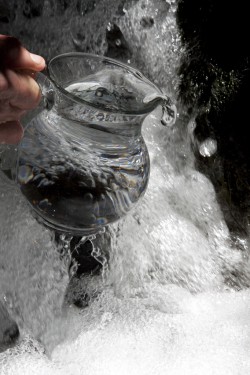
When you decide on your favorite summer workouts—we discussed a few fun options in Part I—you can move on to organize everything so you stay healthy and well-hydrated during your fitness routine.
First of all, add extra care to how you prepare for your workouts. Make sure you are properly hydrated beforehand. Drink small amounts of water frequently, beginning two hours before you go out. I would not necessarily drink too much for 20 to 30 minutes prior to your start, though, because it can make you need to “go” while working out.
If you plan to work out for more than one hour, you might want to run with a water bottle belt, as many athletes do. You also could leave one or more water bottles on the course. If you decide on that strategy, it is best to stay on a loop course. This gives you a chance to replenish every few miles. And, if you want to be absolutely safe, ask a friend to join you on a bike. For bikers, use both your water bottles, and stay ahead of the game by stopping at any convenience store or gasoline station to fill-up your bottles before you need them again.
Listen to Your Body, Stay Healthy
Nothing is more important than listening to your body. If you do not feel well, please be very cautious. Before, during, and after your workouts, the first signs of a possible problem might be heavier breathing, an elevated heart rate, or losing concentration. Consider wearing a heart rate monitor—it can caution you before you run into trouble.
When you feel unwell, admit it to yourself early on and get out of the heat right away. Cool off with a cold towel, use ice cubes, and hydrate! Please, do not wait to see a physician if you do not feel better immediately. Be familiar with some of the early warning signs of overheating: dizziness, fainting, fatigue, hot skin and followed by chills, lack of perspiration, feeling thirsty, and elevated heart rate. If you stop sweating, you most likely are very dehydrated(1).
Also be careful after your workout. Take a dry shirt to put on after your run, and always take some fluid to drink. If you feel cold—even in summer, for example when you come from outside into an air-conditioned room while still wearing your wet workout clothes—change immediately into dry clothes. It may be summer, but you need to stay “warm” after your workouts to avoid weakening your immune system and maybe getting a cold.
For adequate protection, sunscreen, glasses, a summer hat, and a rain jacket are always good to have close by.
Hydrate Well Throughout the Day
 © Betty Shepherd
© Betty Shepherd
It can be very warm and dry during the summer, so make sure you stay cool and hydrated at all times. There are some guidelines I would suggest, and one of my favorite is to keep a bottle of water or a sports drink close by. This will remind you to drink and get replenished with small amounts continuously and evenly spread out throughout the day.
Hydration is critical for many body functions, such as digestion, regulation of body temperature, and the circulatory processes that bring nutrients to the cells and transport waste from them. This is even more understandable when considering that our bodies are up to 75% water in total, depending on age and build, with blood being 83% water and the brain being 75 to 78% water. These are the levels when each of those organs work best(2).
When you get dehydrated, every cell in your body suffers, causing you to feel less fit and fatigued(3). This puts more stress on your body and makes you more prone to illness and disease. And you can be at risk of overheating, which can have terribly serious consequences—including being life-threatening.
For proper hydration, start with juice from a fresh squeezed lemon with lots of water first thing in the morning. It is good for re-hydration after your night’s sleep and also will help your body to detoxify.
And as mentioned earlier, drink enough before, if possible during, and right after your training. It is best to replenish within 30 minutes of finishing your workout—the so-called “recovery window.” I like to eat a big slice of water melon right after my training, it is a great source of water, antioxidants, and easily digested carbohydrates. In the following article “General Guidelines,” you can find more information on this topic.
A Few Thoughts on Summer Nutrition
 © Betty Shepherd
© Betty Shepherd
Many people like to adjust their nutrition and take advantage of everything that is fresh and more available in the summer, like tasty fruits and vegetables. It is berry season—maybe you are lucky enough to be able to pick your own on a berry farm. Eat food that has high water content like melon, citrus fruits, berries, and vegetables.
Diluted fruit juices with 1 part juice and up to 2 parts water can help you to stay hydrated. The juice from sour cherries, for example, has many health benefits and can even support faster strength recovery for runners.
You also can try the many different kinds of unsweetened iced teas. My favorite flavor is mango.
Enjoy what you eat and make it tasty. Add some cool summer nutrition like different kinds of smoothies. Depending on the amount you make, they even can be served as an entire meal. Just add water, berries (like raspberries and blueberries), banana, whey protein, and some ice cubes into a blender. Mix it and enjoy. Or try a variation with mango or pineapple. And for more health benefits, add a teaspoon of ground flaxseeds.
There also are many delicious salad creations with great dressings. You could try a variety of citrus dressings. Other choices of salads include my favorites—fresh cucumber salad with dill and onions or a tomato salad with olives, feta, and basil.
Sashimi and sushi can be delightful lighter dinner fare when well-portioned. And when you prepare your meals, add more vegetables than pasta or potatoes. And how about cold summer soups like water cress and gazpacho?
And for all you BBQ lovers, here are some thoughts on “Healthier Grilling.” I hope you can enjoy many relaxing summer evenings with your family and friends.
Good luck for your summertime fitness!

Sunday, June 10 2012
 © Betty Shepherd
© Betty Shepherd
Summer is such a beautiful time of the year. Happy days with stunning sunrises, long, warm evenings and relaxing afternoons freshened up with lemonade and watermelon. Even on hot days, it is not difficult to find great exercises to keep your fitness level up.
Summer is also special because you can finally do the workouts you might have been missing during the colder months of the year. You even can take advantage of the training sessions you would not necessarily do during the ideal training period for other sports in winter.
You can add cross-training, as well. That means you can work out in other sports or add exercises that support what you normally focus on. It gives you an opportunity to prepare yourself for your upcoming autumn events or improve your fitness and skills for your favorite winter sports. Cross-training can give you a wide variety of workout choices which can enable you to reach your goals.
In the summer, you have a wonderful opportunity to take advantage of the outdoors and experience beautiful connections to nature—the oceans, lakes, rivers, beaches, mountains, and shady woods and forests.
Before we go on, however, I would advise getting a physical before you start your summertime fitness, making sure you are fit enough to work out in those warm conditions and are able to stay ahead of the game. It is a time that is good for more than just goal setting. You also can talk about your fitness ideas and workout possibilities for the upcoming months and decide if they are realistic for you.
Your Favorite Summer Workouts
Of course, in summer—as well as year-round—do activities you enjoy. They might include your favorite ball game, long hikes, water sports, or anything that is giving you excitement and happiness while exercising.
Maybe you have some “wishes” you can turn into goals—like improving your fitness, learning to surf, running your first 5K, hiking a mountain, or biking some new trails by the end of the warmest time of the year. When you follow a path of realistic and achievable short-term goals, it can be much easier to stay motivated and make it fun to reach your goal.
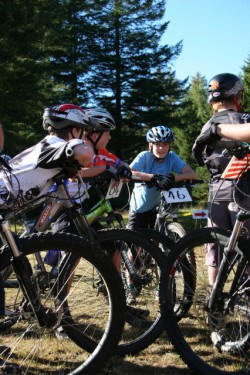 © Betty Shepherd
© Betty Shepherd
It always is a good idea to include your favorite workouts first, then, integrate new opportunities as the summer progresses. By the end of the warmest months, you will have explored and tried different exercises—alternatives you may have been curious about, perhaps, and had thought could be fun for you. Ball games, swimming, water sports, mountain biking, running, hiking, camping, for example, all are great exercises to try during the summer, especially if you had never done so before or if it had been a long time since you did them. And if you are ready to take on multiple challenges, nothing might be better than combining a number of activities.
My favorite summer workouts are those easy and relaxing evening runs, when the sun starts to set and the air is getting fresher, when I can play with those long shadows in the forest. I often combine them with a swim, diving into a lake after my run. Sometimes I jog a few miles to a beach by a lake and cool-off by swimming for some distance, depending on how I feel after my run. I used to do this often as a kid and later during my track season. I have enjoyed it ever since.
As the previous comment illustrates, summer workouts are a great way of rekindling happy childhood memories: those long days of carefree summer vacations from school, playing baseball, basketball, or soccer, or maybe completing a track session in the stadium. Perhaps you have a loving memory of the smell of freshly cut grass. That wonderfully distinctive aroma always reminds me of the newly-mown infield at the local track when I was a kid.
During the warmest time of the year, it is best to wait for temperatures to have fallen in the early morning or the late evening. Any kind of ball game—basketball, baseball, soccer, or tennis—is fun to play in the cooler evenings. With dusk still far away, you can arrange to get together with your friends after work and add informal versions of these games to your other activities. This can be fun and often makes it easier to stay fit.
When I was growing up and started running, we played lots of ball games as warm-ups for our training sessions. A game of team handball or volleyball was just right for us kids. Coming from Germany, soccer always was the favorite. Maybe you can join a group of friends to play a game? You will soon find the countless sprints to get the ball or trying to keep it will definitely give you good cardiovascular exercise. Huffing and puffing, I sometimes had to stop running to catch my breath.
For many of us, nothing is nicer than taking part in summer water sports. You can enjoy the whole day at a lake or the ocean with activities such as paddle boarding, kayaking, surfing, snorkeling, or playing different water ball games with your friends. These all are sports that can provide fun activities for you and your entire family.
If you don’t have the luxury of a few free days, try a nice swim before or after work, or, if time permits, during your lunch break. Swimming is not only a great cardiovascular workout, and refreshing during the summer months, it also can help you recover from more strenuous training like biking or running. And, at the same time, it will improve deeper breathing.
 Dave enjoys kayaking across the state of Florida. © Dave Bracknell
Dave enjoys kayaking across the state of Florida. © Dave Bracknell
A former client of mine started with a few sprint triathlons in the summer and quickly moved up to the Olympic distance in winter. He later discovered that kayaking would be fun for him, too. I got an email message from him with breathtaking photos of the ocean and his kayak resting on a beach. He wrote that he just kayaked across the state of Florida in a charity event.
I can imagine that he had a fun pool party afterwards! It is a great idea to start a party with your family and friends in late afternoon, playing ball and enjoying swim games, and later taking in the sunset while having a super-tasty barbecue.
Could an interesting hike become one of your favorite workouts? Even a leisurely “glow worm and fire flies” hike on a cool summer night might be something you would enjoy. It can be such a fun activity for the whole family. And if you choose a long day hike, you might want to top it off by camping out overnight under the stars.
Change the Venue, Adjust Your Goals, and Explore Cross-Training
Sure, you want to avoid the hottest part of the day—so go inside! Join a gym for the warmest months, and instead of running or biking outside, try the treadmill or the stationary bike or one of the many other aerobic exercise machines available at most gyms. You always can exercise outside during the cooler temperatures around sunrise and sunset.
The nice thing about summer events is that most of them take place in the morning or evening hours. Nothing is better than completing your workout or event and meeting friends for a late breakfast afterwards. “It’s just a piece of pancake!”
Adjust your fitness goals for the warmest time of the year. As always, it is best to set realistic, achievable, short-term goals. I recommend focusing on a few shorter workouts with higher intensity and playful variations in speed. Perhaps your goal might be to become faster in your sport during the summer. Then in autumn, you can add some endurance and focus on longer events again.
Once you accomplish your summer goals, you can use your improved fitness to achieve great results in your events later in the year.
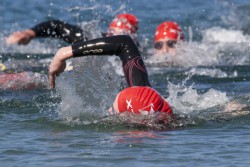 © Betty Shepherd
© Betty Shepherd
Here are some ideas. If you are a triathlete, you might want to improve one of your disciplines to be better prepared for competition in the fall. To work on your swimming might be a good idea. Or you might change from running to more biking, and in the colder months add longer running workouts again. There are great duathlon competitions in the summer. To work on improving your speed, you may decide to prepare for a sprint triathlon or a sprint duathlon, instead of the longer versions.
Many runners may just have finished a spring marathon. The warm summer months are ideal to prepare for a 5K, and in late August one could prepare for a 10K. Then, in September, you can get ready for a half marathon. All the training and goal setting can be done with the ultimate aim of a faster marathon. Or simply enjoy the shorter distances as your main event all summer. That is good, too!
You also can switch from one sport to another. Think “off season training.” For runners, bike and swim instead of doing high mileage running. Some bikers go from the road into the forest and mountain bike, it is a great way to improve your skills. Enjoy water sports like kayaking or paddle boarding. Compete in team swimming events, relays are always great fun.
A good goal could be to work on other elements of fitness, like strength or technique training, especially if these are areas in which you already want to improve. To do this, you may want to include these new elements in your routine during the summer so you are better prepared for your upcoming events later in the year.
I love these elements of cross-training. They can give you a chance to try out a variety of workouts—not doing the same activity every day. And they can be done indoors during the warmest hours of the day. Think about it as something you can look forward to complement your training. Deep-water running, core strengthening, light weights, stretching and yoga… they all can be added to your summertime fitness routine. In this manner, you can condition your body for your fall events—to be a better runner, biker, or golfer—and for your winter sports to be a stronger skier, snowboarder, or skater.
Be prepared to adjust your workouts according to the weather conditions on any given day. It can be hot, humid or rainy, and setting a new and easier goal will help you achieve them. Maybe you, too, would love to combine some of your runs with a cooling swim afterwards.
And finally, a general suggestion for your summer workouts: start them slowly, increasing your workload in gentle increments. The weather conditions can be challenging and even deceptive. By starting your workouts carefully, keeping your strength in reserve, you will be able to keep your body temperature and your pulse lower. And you will not get so fatigued.
In many climates, temperatures can change dramatically over the course of the day, so always be aware of the conditions in which you do your activities and training. Of course, during summer months, adequate hydration should always be on your mind.
Fitness Programs and Sport Events You Can Join
Check out recreational leagues and programs for adults and kids in your area. Your town, local fitness club, and local businesses might offer programs for many sports and events, and maybe you would like to join one of them. This way you also might meet new friends and enjoy staying fit together. It might even not feel like working out hard at all.
There are many events over the summer that may be of interest to you. Some of them are charity rides or runs where you also can get the satisfaction of helping your community or a charity that touches your heart like SOS Outreach with which Take The Magic Step is a partner.
In “Summertime Fitness: Part II,” I will explore proper hydration and offer a few thoughts on summer nutrition.
Until then, I hope you can enjoy your fun and cool summertime fitness!

Please Spread Our News With Others
|







 breaks. Bone strength in later life depends upon your peak bone mass in youth. An active lifestyle in youth can increase maximum bone density.
breaks. Bone strength in later life depends upon your peak bone mass in youth. An active lifestyle in youth can increase maximum bone density.